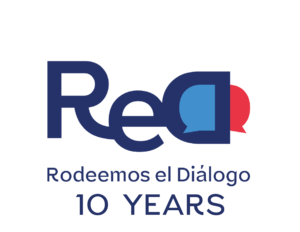Truth Commission Snapshot 21
Rodrigo Londoño and Salvatore Mancuso admit responsibility in front of the Truth Commission
On the 4th August 2021, the Truth Commission held a meeting for admitting of responsibility, in which the former AUC (United Self-Defense Forces of Colombia) paramilitary leader Salvatore Mancuso and the former commander of the FARC-EP (Revolutionary Armed Forces of Colombia-People’s Army) Rodrigo Londoño gave testimonies. Victims, representatives of the international community and members of the Truth Commission were all present and had the opportunity to ask questions about the actions of both former commanders during the armed conflict. The meeting focused on two topics: firstly, the relationship of the armed groups with the political establishment and state institutions, and secondly, the rationale and practice of victimization.
The armed groups and the political establishment
From the testimonies provided by Londoño and Mancuso, a clear distinction can be established regarding the relationship between the illegal armed groups and the political establishment. According to Londoño, the actions of the FARC-EP during the conflict were aimed at disrupting the normal functioning of the state with the objective of generating ungovernability. This explains the different threats to candidates in local elections and includes the assassination of the governor of Antioquia, Guillermo Gaviria Correa and his peace assessor, Gilberto Echeverri Mejía. Londoño admitted that those assassinations were a mistake.
On the other hand, the link between the AUC and state institutions is more complex. Mancuso highlighted the role of so-called ‘political commissioners’ who were those in charge of establishing pacts with the local, regional and national political establishment, people who played a key role in the expansion of the AUC’s organization. According to Mancuso, the paramilitary groups sought to coopt the political system with the aim of expanding state presence and actions in historically forgotten territories, and in this way provide economic development. Truth Commissioners questioned this version of events, as they recalled that this policy was sustained by the assassination of those involved in any form of political dissidence. In addition to his aforementioned comments, Mancuso described the importance of the Convivir – security cooperatives created by the state – in the complicity between the state and paramilitary forces, as he argued that the Convivir facilitated joint work between the armed forces and illegal armed groups. He also underlined the role of some sectors of the Colombian state in providing lists of selected targets for assassination, and more clearly, in the extermination of the Unión Patriótica party.
Rationale and practice of victimization
Londoño’s testimony about the FARC-EP’s rationale and form of victimization was based on two main issues: the guerrilla’s attacks on municipalities and the indiscriminate use of anti-personnel mines. These two issues have the common denominator of an inconsistency between the practices used and the principles declared by the organization, as civilians always ended up in the middle as victims. Regarding the first issue, Londoño argued that the FARC-EP’s principal objective was taking over police positions and military bases, as they were the sources of procuring weapons. However, he admitted that guerrilla attacks were never prohibited by the organization in spite of there being an awareness of their consequences for civilians. Regarding anti-personnel mines, Londoño explained that this was a strategy intended to delay the advance of the enemy. He admitted that many of these mines were never removed by the guerrillas, who failed to take into account the consequences that these had on civilians.
Mancuso was questioned about the massacres perpetrated by the paramilitaries and land grabbing. Mancuso admitted that the massacres were a strategy intending to destroy the alleged social bases of the guerrillas during the armed conflict, which predominantly affected civilians who were stigmatized by the ‘good vs evil’ narratives of the actors of the armed conflict. He also referred to attacks on indigenous communities, in which, according to his interpretation of events, there was a guerrilla presence given the ease of access to resources and the impossibility of the state entering these zones in order to fight guerrilla forces. On the other hand, land grabbing was carried out with the complicity of business groups who saw an opportunity to obtain productive land at a much reduced cost. Mancuso argued that this was carried out with the aim of promoting an agro-export development model to the detriment of the peasant economy. The prime example of this is the participation of the agro-exporter trade association of the Urabá region in Antioquia, which Mancuso demonstrated through the case of Tulapas, where there were more than 4000 victims of forced displacement.
Other topics covered in the event included the links between drug trafficking and the armed conflict, as well as the origins of every illegal armed group, which makes these testimonies essential materials for the recognition, the non-repetition and the clarification of what happened in the armed conflict.
Rodeemos el Diálogo celebrates the holding of these public spaces for admitting responsibility as fundamental steps in the gathering of testimonies of those who were protagonists of the armed conflict.


